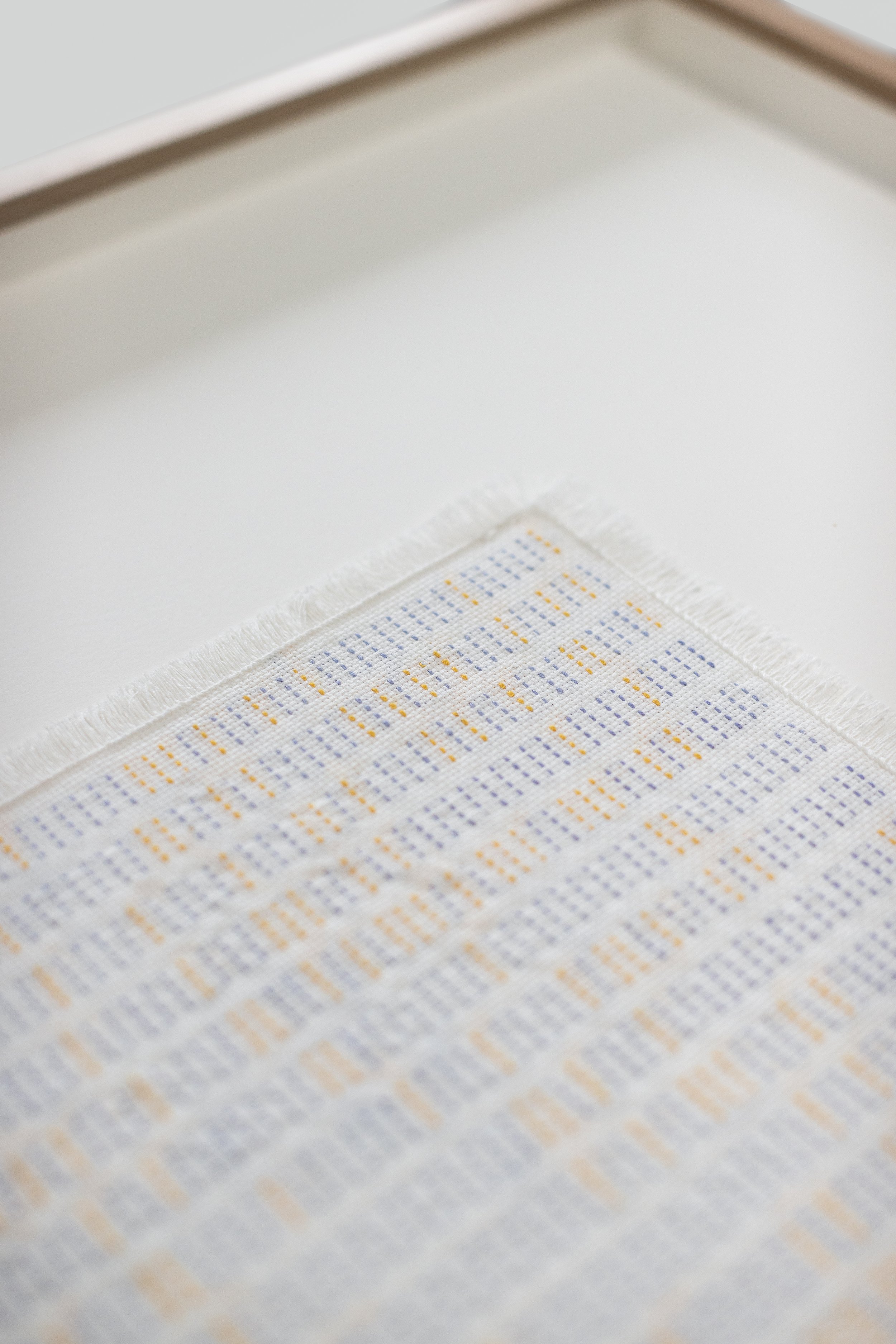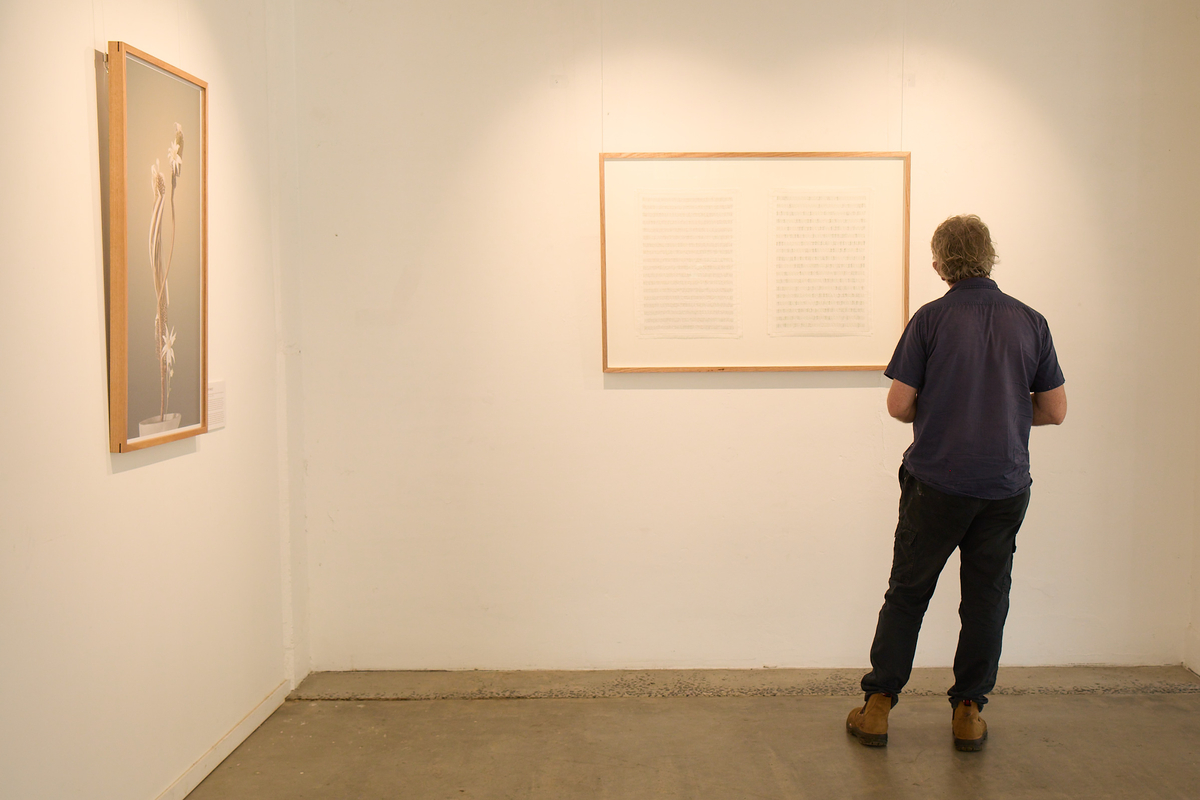STITCHING AS STORAGE
It’s generative, by nature
Artworks from my series 'Stitching as Storage' explore how textiles can store, index, and arrange ecological data, with a particular focus on primordial blooms, modern descendants of some of the earliest flowering angiosperms that first emerged during the Cretaceous period
The idea that nature can be generative has become foundational to my practice, leading me to investigate natural algorithms within ecological systems
To retrieve the biodata of plants, sensors are directly attached to the plant to record the changes in electrical conductivity that transpire through the stomata: a direct channel between the plants’ internal autonomous systems and the conditions of the external world. Each significant change within the stomata is communicated to the sensor, initiating the recording process. This biodata is then sonified and notated as a rhythmic composition, where each embroidered line signifies the duration of an 1/8th note, encoding the magnolia's biological rhythms into geometric harmony.
Conforming to the principles of aleatoric composition, the rhythm is dependent on the plant’s intrinsic stochastic rhythms at the time of recording. The notation is an algorithmic mark making instance that articulates a rule-based compositional procedure symbolizing the “beat” of the plant. The choice of stitching with two color values nods to the most basic form of computer code: base-2, wherein two binary values are utilized to constitute conversation, or in this case, rhythmic notation.
BLUE WATERLILY [SOLD]
presented by Sothebys | Contemporary Discoveries
•
Blue Waterlily is composed of 7360 hand-embroidered silk stitches on a grid-based cotton cloth canvas. Embedded within the geometric abstraction is a cryptographic aleatoric notation derived from the stochastic biodata of the magnolia.
Recognised as one of the earliest flowering plant lineages with fossils dating back to the Cretaceous period over 100 million years ago, the blue waterlily is a primordial bloom that embodies wisdom and perseverance through its existence within and throughout deep time.
The artwork is inscribed as an Ordinal to Satoshi #1977341250000000 (26 October 2024), a satoshi that was mined on the day the Blue Waterlily biodata was originally obtained
Blue Waterlily debuted through Sothebys in their Contemporary Discoveries programme on 8th July 2025. Blue Waterlily was one of 23 artworks curated for the digital gesture: key works that blur the boundaries between the physical and the digital, offering a nuanced reflection of how contemporary artists harness the tools of their time, algorithms, artificial intelligence, quantum computing, and generative systems.
Link to Sotheby’s




Blue Waterlily, Mia Forrest, 2025, hand embroidery (silk thread, cotton cloth), 920mm x 900mm
Artwork attached to cotton rag matboard, encased in a Tasmanian Oak Frame, museum-grade ultra vue glass
Digital Medium: Ordinal Inscription, .jpg, Sat #1977341250000000 (26 October 2024), a satoshi that was mined on the day the blue waterlily biodata was originally obtained
WIRRIMBIRRA WHITE [SOLD]
presented by House of Fine Art X Phillips Auctions
•
Wirrimbirra White is composed of 7360 hand embroidered stitches on a grid-based cotton cloth canvas. Embedded within the embroidered geometric abstraction is a notated rhythm derived from the stochastic biodata of the white waratah, a rare newly discovered colour variant of the iconic red waratah.
A primordial bloom, the waratah belongs to the Proteaceae family, a lineage that traces its evolutionary roots back over 90 million years to the Gondwanan supercontinent during the Late Cretaceous period. The white waratah embodies wisdom and perseverance due to its existence within and throughout deep time.
The white waratah is seldom seen in the wild. Similarly, its presence in the embroidery is subtle, nearly imperceptible. The delicacy of the faint stitching invites the viewer into an intimate act of looking.
The artwork is inscribed as an Ordinal to satoshi #1976480000000000 (Oct 8, 2024 9:43 PM, 2024), a satoshi that was mined on the day the waratah biodata was originally obtained.
Wirrimbirra White will debut on 15th May 2025 through House of Fine Art in collaboration with Phillips, as part of the Digital Art Awards, of which it is a finalist in the Innovation category.
Link to Phillips





Wirrimbirra White, Mia Forrest, 2025, hand embroidery (silk thread, cotton cloth), 910mm x 930mm
Artwork attached to cotton rag matboard, encased in a Tasmanian Oak Frame, museum-grade ultra vue glass
Digital Medium: Ordinal Inscription, .jpg, Sat #1976480000000000 (Oct 8, 2024, 2024), a satoshi that was mined on the day the waratah biodata was originally obtained
MAGNOLIA [SOLD]
presented by Sothebys | Gamma.io
•
Magnolia is composed of 4032 hand-embroidered cotton stitches on a grid-based cotton cloth canvas. Embedded within the geometric abstraction is a cryptographic aleatoric notation derived from the stochastic biodata of the magnolia.
Recognised as one of the earliest flowering plant lineages, with fossils dating back to the Cretaceous period over 100 million years ago, the magnolia is a primordial bloom that embodies wisdom and perseverance through its existence within and throughout deep time. With large, spirally arranged tepals and beetle-pollinated blooms, it retains many ancestral traits of the first angiosperms.
The artwork is inscribed on sat # 1945185800000000 (Aug 9, 2023, 11:56 AM), a satoshi that was mined on the day the magnolia biodata was originally obtained
Magnolia debuted through Sothebys Metaverse in collaboration with Gamma.io, as part of the “Natively Digital: Art on Bitcoin” on 22nd May 2024
Link to Sotheby’s





Magnolia, Mia Forrest, 2024, hand embroidery (cotton thread, cotton cloth), 650mm x 650mm (25.5 x 25.5in).
Artwork attached to cotton rag matboard, encased in a Tasmanian Oak Frame, museum-grade ultra vue glass
Digital Medium: Ordinal Inscription, .webp, Sat # 1945185800000000, (Aug 9, 2023, 11:56 AM), a satoshi that was mined on the day the magnolia biodata was originally obtained
REMNANTS
TRUE NORTH: From the Forest Floor (group exhibition), Grafton Regional Gallery
curated by Chris Willcocks
Once a vast 75,000-hectare expanse of subtropical rainforest in northeastern NSW, the Big Scrub was home to extraordinary biodiversity. However, due to extensive land clearing and colonial agribusiness, only 0.13% remains in isolated fragments today.
Remnants is a diptych composed of 8896 hand-embroidered silk stitches on a grid-based cotton cloth canvas. Embedded within the geometric abstraction is an aleatoric notation derived from the rhythmic biodata of two species from the Big Scrub Booyong Flora Reserve remnant: the Giant Water Gum, a native tree (and largest known in the world), and the Cats Claw Creeper, an introduced and invasive species. Within an ecosystem, these two have a tensile relationship, explored in the accompanying audio piece. The audio showcases the rhythmic pulses from each plant, assigned to the L and R channels, respectively, thank you to Sam Pankhurst for the audio experience
Conceived as an ongoing iterative exhibition at Grafton Regional Gallery, True North showcases the dynamic and diverse practices of artists living and working in the Northern Rivers
In True North: From the Forest Floor, guest Curator Christine Willcocks draws on her deep connection to the region’s rich biodiversity, selecting artists who respond intrinsically to the landscapes around them. Subtropical rainforests, Big Scrub, and coastal littoral forest provide a common thread for artists working across painting, installation, sculpture, film, sound, and performance.
Remnants is a finalist in the Ravenswood Women’s Art Prize, the highest value professional art prize for Women in Australia



Remnants (fig. 1 Syzygium francisii, Fig. 2 Dolichandra unguis-cati), 2025, hand embroidery silk thread on cotton cloth, 122cm x 86cm x 5cm
Artwork attached to cotton rag matboard, encased in a Tasmanian Oak Frame, museum-grade ultra vue glass
Framed at Blueboy studio, Mullumbimby
Artist Notes:
I often turn to the natural world as a source of influence; nature inherently contains generative and algorithmic systems, from the fibonacci sequences in leaf arrangement of plants and shell structure, to cymatic patterns observable in sound and vibration, to murmurations in both birds and fish, to lissajous curves realized through gravity… as an artist my challenge is to somehow build a practice methodology around these systems to make them quantifiable and actionable.
The frame of thinking that artworks can be ‘generative, by nature’ was a phrase first introduced to me by Misha de Ridda in his series of the same name, and a fantastic resource to refer to has been Peter Bauman’s editorial historic survey of generative art on Le Random, which posits the lineage of generative art today brewing from many developments in mathematical and algorithmic discoveries since the pre-modern era (from c. 70,000BCE).
My work attempts to hone in on the premise that art can be generative by nature - adopting ecological systems and rule-based processes as a collaborative framework. While generative art is often associated with computer-based systems, I found lasting resonance in Philip Galanter’s 2003 essay Generative Art Theory (see: Chapter 5: Generative Art Theory from A Companion to Digital Art, First Edition, 2016, edited by Christiane Paul), on what defines generative art today, detaching the synonymously intertwined “computer art” and “generative art” from one another; generative art is
“any art practice where the artist uses a system [...] computers did not pave the way for generative art; generative art helped to pave the way for computers”.
I am catching the ball he is throwing.

